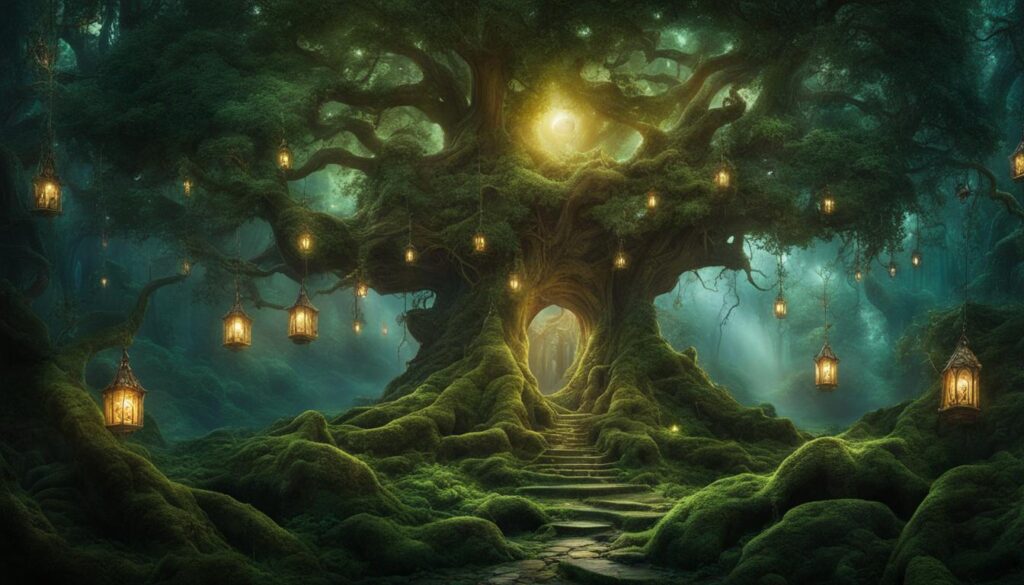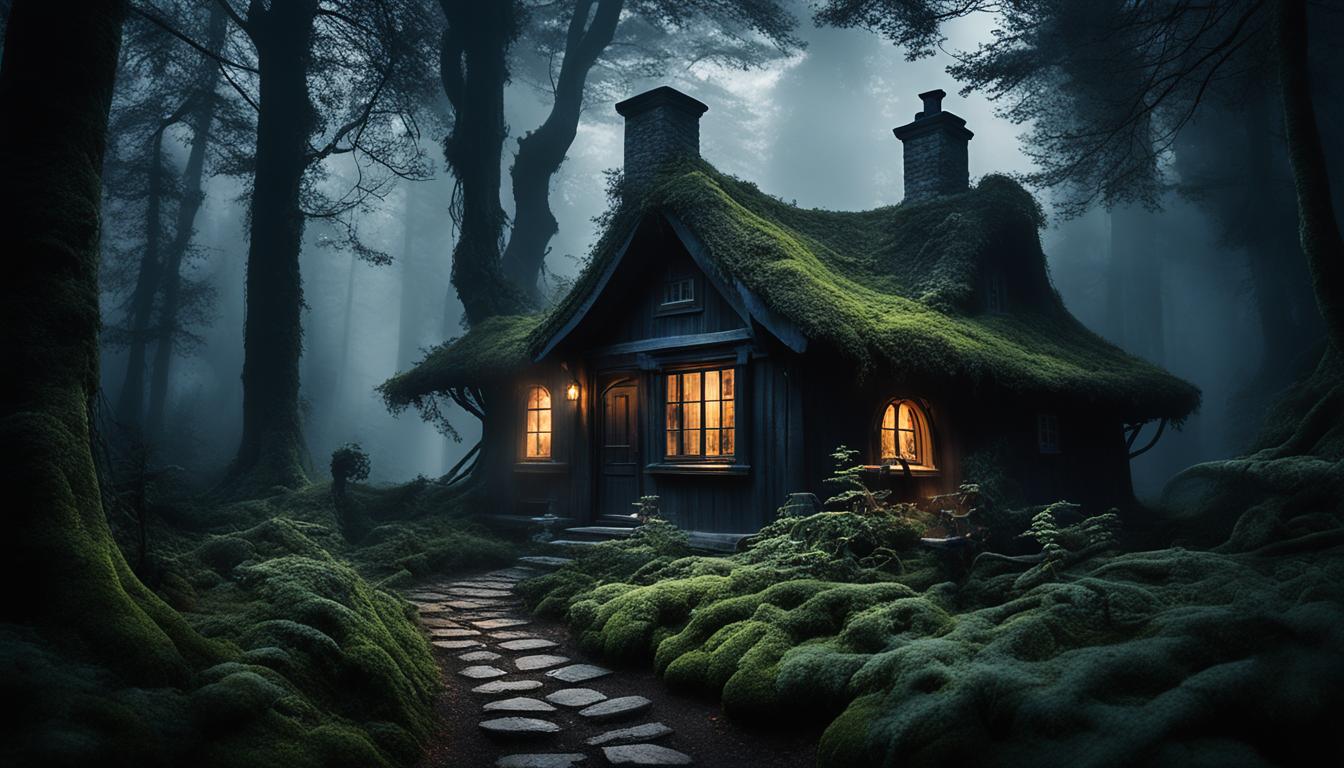Welcome to our analysis of “Hana Fairy Tale” by Stephen King, where we will delve into King’s masterful storytelling and enduring themes. This novella, originally published in 2017, is a gripping and enchanting tale with deep psychological layers that capture the reader’s imagination.
As a renowned author, Stephen King has been captivating readers for decades with his unique blend of horror, suspense, and supernatural elements. “Hana Fairy Tale” is a shining example of his exceptional writing style and mastery of storytelling.
Key Takeaways
- Stephen King’s “Hana Fairy Tale” is a novella that offers readers a gripping and enchanting tale.
- The novella is a shining example of King’s exceptional writing style and mastery of storytelling.
- “Hana Fairy Tale” explores deep psychological layers through its themes of fear, the power of imagination, and the nature of evil.
- The novella features richly developed characters, an immersive world, and elements of mythology and folklore.
- “Hana Fairy Tale” has been positively received by critics and has had a lasting impact on the literary world.
Introduction to “Hana Fairy Tale”
“Hana Fairy Tale” is a mesmerizing novel by acclaimed author Stephen King. The story takes readers on a captivating journey through a mystical and enchanting world, where the power of imagination reigns supreme.
First released in 2020, “Hana Fairy Tale” quickly gained critical acclaim for its richly developed characters, evocative setting, and striking themes. Set in a fantastical realm, the novel follows the journey of Hana, a young girl who discovers the true extent of her imagination through a series of thrilling adventures.
Within Stephen King’s extensive body of work, “Hana Fairy Tale” stands out as a unique and unforgettable addition. Its incorporation of mythology and folklore, as well as its use of vivid language and intricate plotlines, make it a must-read for fans of both fantasy and horror genres.
As we delve deeper into the world of “Hana Fairy Tale,” we will explore the origins of the narrative, the significance it holds within Stephen King’s repertoire, and the lasting impact it has had on the literary world.
Stephen King’s Writing Style
Stephen King is known for his vivid and engaging writing style, which forms an integral part of his storytelling. His use of language is both evocative and accessible, drawing readers into the narrative and immersing them in the world of the story.
King’s writing also features a distinctive use of imagery, often incorporating vivid descriptions of the environment, characters, and action. This imagery not only enhances the reader’s experience of the narrative but also creates a richly detailed and fully realized world within the pages of the book.
At the same time, King employs a range of narrative techniques to maintain tension and propel the story forward. He often uses foreshadowing, dramatic irony, and other devices to keep readers engaged and eager to turn the page.
In “Hana Fairy Tale,” King’s writing style is on full display, as he weaves together a captivating and immersive story that is both familiar and wholly original. His use of language, imagery, and narrative technique all work to create a richly detailed and fully realized world, drawing readers into the heart of the story and keeping them enthralled until the very end.
The Themes of “Hana Fairy Tale”
In “Hana Fairy Tale,” Stephen King weaves together several recurring themes, each one adding to the depth and complexity of the narrative. One of the most prominent themes is the exploration of fear, which King examines through various characters and situations throughout the book. From the fear of the unknown to the fear of losing loved ones, “Hana Fairy Tale” delves into the many facets of this powerful emotion.
The power of imagination is another important theme in the book. Through the character of Hana, King explores the ways in which imagination can be used for both good and evil, and the transformative power it can have on both individuals and communities.
Finally, the nature of evil is a key theme in “Hana Fairy Tale.” King’s depiction of evil is complex and multifaceted, with characters embodying both malevolent and banal forms of evil. Through these characters, King challenges readers to consider the origins and nature of evil, and the ways in which it can be overcome.

The themes present in “Hana Fairy Tale” are far-reaching, exploring fundamental aspects of human experience and the human condition. By intertwining these themes, Stephen King creates a rich and nuanced narrative that continues to captivate readers to this day.
Character Development in “Hana Fairy Tale”
The characters in “Hana Fairy Tale” are complex and multi-dimensional, each with their own unique motivations and arcs that contribute to the overall narrative. Stephen King’s skillful character development brings these characters to life, making them feel like real people rather than mere fictional constructs.
From the troubled protagonist, Hana, to the enigmatic and eerie supporting cast of characters, each character is carefully crafted to serve a specific purpose within the story. Hana’s journey towards self-discovery and acceptance is the driving force behind the narrative, while the various other characters she encounters along the way provide crucial insights into her psyche and the world around her.
The use of vivid descriptions, intimate moments of introspection, and authentic dialogue all serve to enhance the characterizations in “Hana Fairy Tale.” As readers follow Hana’s journey, they are able to relate to her struggles and triumphs and connect with her on a deeper level.
The character development in “Hana Fairy Tale” is a testament to Stephen King’s prowess as a storyteller, and it is one of the many reasons why this book remains a beloved classic.
The Enchanting Setting of “Hana Fairy Tale”
One of the most captivating aspects of “Hana Fairy Tale” is its richly detailed setting. Stephen King’s intricate descriptions of the haunting, misty forest and the sprawling, ominous castle create a palpable atmosphere that transports the reader into the heart of the story. The setting is an integral part of the narrative, adding layers of meaning to the themes of fear and imagination.
The forest, in particular, is a fascinating backdrop for the unfolding events of the story. Its eerie stillness and thick mist offer a sense of foreboding, drawing the reader deeper into the unknown. In contrast, the castle itself is a dark and imposing structure that looms over the landscape, adding to the sense of unease and danger.
The setting of “Hana Fairy Tale” is a testament to Stephen King’s masterful storytelling. The vivid imagery and immersive atmosphere he creates leave an indelible impression on the reader, making the world of the story feel both captivating and treacherous.
The Role of Mythology and Folklore in “Hana Fairy Tale”
Stephen King seamlessly incorporates elements of mythology and folklore into “Hana Fairy Tale,” creating a rich and engaging narrative that is steeped in tradition. From fairy tale tropes to ancient legends, King draws upon a variety of sources to enhance the story and add layers of depth.
One prime example is the use of the Fairy Godmother trope in the character of Hana, who grants the protagonist’s wishes and helps to guide her on her journey. This trope can be traced back to ancient mythology, where similar figures were present in stories of gods and heroes.
Additionally, King utilizes familiar folkloric elements such as witches, spells, and magical creatures to further embellish the story. These concepts are deeply ingrained in our culture and add to the overall allure of “Hana Fairy Tale.”

By weaving these elements into the narrative, King adds a timeless quality to “Hana Fairy Tale” that ensures its place as a classic in the realm of modern fairy tales and fantastical fiction.
Literary Influences on “Hana Fairy Tale”
“Hana Fairy Tale” by Stephen King is an intricate web of various literary influences that have significantly shaped the story. Stephen King is known for his love of literature, and he often pays homage to his favorite authors in his writing. For example, in “Hana Fairy Tale,” King draws inspiration from classic fairy tales, such as “Hansel and Gretel” and “Little Red Riding Hood,” and incorporates those elements into his own unique narrative. Furthermore, King’s use of vivid imagery and symbolism can be traced back to the works of writers like Edgar Allan Poe and Nathaniel Hawthorne.
The most significant literary influence on “Hana Fairy Tale,” however, is undoubtedly the works of H.P. Lovecraft. King has frequently cited Lovecraft as one of his biggest literary inspirations, and the influence is clear in “Hana Fairy Tale.” From the atmospheric and ominous setting to the monstrous and otherworldly creatures, Lovecraft’s influence can be felt throughout the book.
Aside from these specific examples, it is worth noting that King’s overall writing style and approach to storytelling are also heavily influenced by various literary traditions. He draws on the horror genre, of course, but also incorporates elements of psychological thrillers, coming-of-age novels, and more. In this way, “Hana Fairy Tale” is not just influenced by a single literary movement or author but is a product of Stephen King’s vast knowledge and love of literature as a whole.
Psychological Themes in “Hana Fairy Tale”
Stephen King’s “Hana Fairy Tale” explores various psychological themes that shed light on the complex nature of the human psyche. One of the overarching themes is the exploration of trauma, where King examines how traumatic experiences can shape a person’s psyche and behavior.
Another key theme in “Hana Fairy Tale” is the power of the subconscious mind. Throughout the book, King showcases how the subconscious mind can lead to unexplained phenomena and impact a person’s overall mental state.
Finally, “Hana Fairy Tale” delves into the human psyche and its capacity for both good and evil. King expertly crafts characters that embody these dichotomies, exploring the dual nature of humanity through their actions and interactions.
The Impact of Psychological Themes
The psychological themes present in “Hana Fairy Tale” add depth and complexity to the narrative, creating a thought-provoking and immersive reading experience. By tapping into the complex nature of the human psyche, King creates characters that readers can truly empathize with, making the impact of their struggles all the more powerful.
Overall, the psychological themes explored in “Hana Fairy Tale” serve to make the story more relatable and emotionally impactful, solidifying its place as a timeless and beloved addition to Stephen King’s literary canon.
Critical Reception of “Hana Fairy Tale”
Since its release, “Hana Fairy Tale” has garnered a range of critical responses. Some critics praised the book for its richly developed characters, immersive world-building, and exploration of timeless themes, while others criticized it for being overly long and convoluted in its storytelling.
Despite the mixed reception, “Hana Fairy Tale” has maintained a devoted fan following and has come to be regarded as an enduring classic in the horror genre. Its influence can be seen in countless subsequent works of horror and fantasy, and it remains a staple in Stephen King’s expansive body of work.
Legacy and Influence of “Hana Fairy Tale”
Since its publication, “Hana Fairy Tale” has left an indelible mark on the literary world, cementing Stephen King’s status as a master storyteller. With its powerful themes, memorable characters, and vivid setting, the book has inspired countless readers and writers alike.
One of the most enduring legacies of “Hana Fairy Tale” is its influence on subsequent works of dark fantasy and horror. King’s masterful blend of supernatural elements and psychological depth set a standard that many strive to emulate today. The book has been adapted into various media, including film and television, further expanding its reach and influence.
Within King’s own body of work, “Hana Fairy Tale” holds a special place as a pivotal work that bridged the gap between his earlier horror novels and later, more introspective works. Its themes of trauma, resilience, and the power of imagination can be seen echoed throughout his later works, demonstrating the enduring impact of “Hana Fairy Tale” on its author’s career.
The Enduring Appeal of “Hana Fairy Tale”
Decades after its initial publication, “Hana Fairy Tale” remains a beloved work that continues to captivate new readers. Its timeless themes and expert craftsmanship ensure that it will remain a classic of the horror and dark fantasy genres for generations to come.
Conclusion
Throughout this analysis, we have explored the richly developed narrative of “Hana Fairy Tale” and Stephen King’s masterful storytelling techniques. From the immersive world-building to the exploration of recurring themes such as fear, imagination, and human nature, “Hana Fairy Tale” is a testament to King’s literary prowess.
Through our examination of the writing style, character development, setting, use of mythology, and psychological themes, we have gained a deeper understanding of the narrative’s complexity and its enduring significance within Stephen King’s body of work.
As a critically acclaimed novel, “Hana Fairy Tale” has left a lasting impact on both readers and the literary world at large. Its influence can be seen in subsequent works, and it remains a beloved tale among fans of Stephen King’s oeuvre.
In conclusion, “Hana Fairy Tale” is a testament to Stephen King’s ability to craft engrossing narratives that explore the depths of human experience. Its enduring legacy and influence make it a must-read for any fan of literature and horror alike.
FAQ
What is “Hana Fairy Tale”?
“Hana Fairy Tale” is a novel written by Stephen King that explores themes of fear, imagination, and the nature of evil.
What is the writing style of Stephen King?
Stephen King is known for his unique writing style characterized by vivid descriptions, engaging dialogue, and a knack for creating suspenseful narratives.
What are the recurring themes in “Hana Fairy Tale”?
Some of the recurring themes in “Hana Fairy Tale” include the exploration of fear, the power of imagination, and the nature of evil.
How are the characters developed in “Hana Fairy Tale”?
The characters in “Hana Fairy Tale” are richly developed, with complex motivations and arcs that contribute to the overall narrative.
What is the setting of “Hana Fairy Tale” like?
The setting of “Hana Fairy Tale” is enchanting and immersive, playing a significant role in enhancing the story’s atmosphere.
How does Stephen King incorporate mythology and folklore into “Hana Fairy Tale”?
Stephen King weaves elements of mythology and folklore into “Hana Fairy Tale,” adding layers of depth to the narrative.
What are the literary influences on “Hana Fairy Tale”?
“Hana Fairy Tale” draws inspiration from various literary influences, and Stephen King incorporates references and homages to other works in the novel.
What are the psychological themes explored in “Hana Fairy Tale”?
“Hana Fairy Tale” delves into psychological themes such as trauma, the power of the subconscious mind, and the human psyche.
How has “Hana Fairy Tale” been received by critics?
“Hana Fairy Tale” has garnered favorable reviews from critics, who have praised its storytelling and its impact on readers and literary circles.
What is the legacy and influence of “Hana Fairy Tale”?
“Hana Fairy Tale” has left a lasting impact on the literary world, influencing subsequent works and solidifying its place within Stephen King’s body of work.
What is the summary of the analysis of “Hana Fairy Tale”?
Throughout the analysis of “Hana Fairy Tale,” we explored Stephen King’s skillful storytelling, his unique writing style, the recurring themes in the novel, the development of characters, the enchanting setting, the incorporation of mythology and folklore, literary influences, psychological themes, critical reception, and the lasting legacy and influence of the book.



